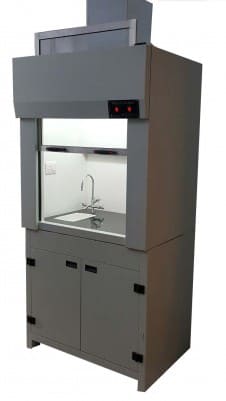

Sat Jul 30, 2022
Perchloric Acid Fume Hood
A perchloric acid fume hood is a specialized type of fume hood designed to safely handle perchloric acid (HClO₄), particularly when it is being heated. It's different from a standard fume hood because it has a built-in wash-down system and is constructed from specific materials to prevent explosions.
When heated, perchloric acid vapors can condense in a fume hood's ductwork. These vapors can react with organic materials and dust to form shock-sensitive perchlorate crystals that are highly explosive. The crystals can accumulate over time and detonate with even minor vibrations, posing a significant risk to laboratory and maintenance personnel. A standard fume hood is not designed to prevent this dangerous buildup.
To address the unique hazards of perchloric acid, these fume hoods have several specific design features:
Wash-Down System: This is the most critical feature. The hood and its exhaust ductwork are equipped with a series of nozzles that spray water to thoroughly rinse away perchlorate residues. This prevents crystal formation. The wash-down system should be used after every use involving heated perchloric acid.
Dedicated Ductwork: Perchloric acid fume hoods must have their own dedicated, straight-run exhaust system. They should not be connected to a shared or manifolded exhaust system with other fume hoods. This prevents cross-contamination and the buildup of perchlorates in other ducts.
Construction Materials: The interior surfaces, ductwork, and exhaust fan are made from corrosion-resistant materials like stainless steel (e.g., Type 316) or certain plastics (like u-PVC or polypropylene). This ensures the hood can withstand the highly corrosive nature of the acid and that perchlorates don't react with the hood's components.
Sloped Surfaces: The interior and ductwork are designed with coved and seamless surfaces that are sloped to a drain. This facilitates the easy and complete removal of all wash-down water and any chemical spills.
Maintenance: Regular maintenance is crucial. The hood and its ductwork must be periodically inspected and thoroughly cleaned to ensure there is no perchlorate buildup. Special testing, such as the diphenylamine test, can be used to check for perchlorate residues.